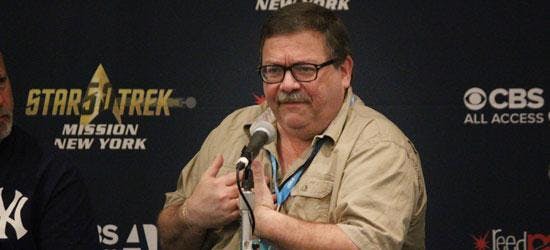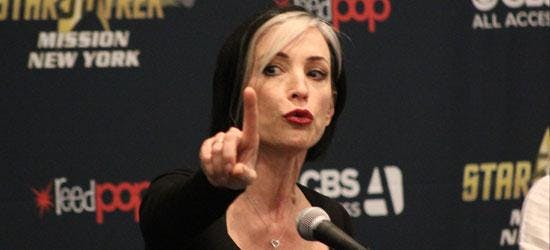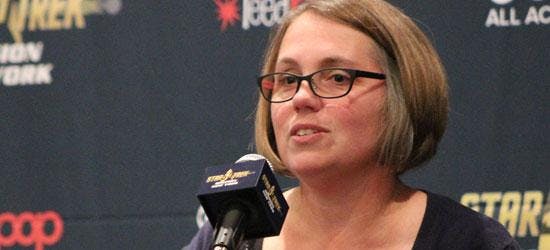Published Sep 4, 2016
50th Anniversary All-Star Crew Named at Mission New York
50th Anniversary All-Star Crew Named at Mission New York

Star Trek: Mission New York wrapped its three-day celebration with panels ranging from science and space to fashion, a trio of Trek's leading ladies and a very special 50th anniversary version of One Trek Mind Live.
One Trek Mind Live: All-Star Crew
Jordan Hoffman led a raucous One Trek Mind Live session to determine Star Trek's 50th Anniversary All-Star Crew. After much playfully heated debate, including Janeway vs Sisko for captain, LaForge vs Scotty vs O'Brien for chief engineer, Paris vs Sulu for helmsman, and especially the Wild Card options, Seven of Nine, Jadzia Dax or Data, the fans selected their crew:

The Lost Years: Treks That Never Were (a/k/a What Does the Son of Good Need with a Starship?)
A group of Trek authors, including Mark Altman, Michael Jan Friedman and Edward Gross, joined by Roger Lay, spent an hour detailing Trek near misses, episodes and movies that nearly came to pass.

It's true, for example, that Kirk almost duked it out with Jesus on the bridge of the Enterprise. It would have occurred in a TOS episode that Norman Spinrad wrote called "He Walked Among Us." It fell apart, Gross explained, when producer Gene Coon rewrote the serious story to make it humorous and maneuvered to cast Milton Berle as the God character.
One idea was Prison Planet, a Khan prequel with him and his followers on Ceti Alpha V. Most fans are aware of The Academy Years, Harve Bennett's proposed Starfleet Academy project. Another story involved Kirk and President Kennedy, with Kirk finding Kennedy... arrogant. Rick Berman, in the 90s, was supposed to oversee a 30-minute Trek IMAX film starring members of the various Trek shows.

In the early 70's, an idea for a Trek story called The Cattlemen was floated. "It was about Enterprise encountering a planet of intelligent cows," Gross said. "It was the most bizarre pitch for a Star Trek episode, especially from Gene Roddenberry."

The project that came closest to being produced was Planet of the Titans, led by director Philip Kaufman. It was another encountering-God story, ironically with no Roddenberry involvement. It'd focus on Spock, with Kirk more or less sideline and later killed off. Kaufman wanted the legendary Toshiro Mifune to play a Klingon. Art was commissioned and things looked good. And then Paramount, Lay explained, "said, 'There's no money to be made in science-fiction,' so they pulled the plug on it."
Then, of course, there was Phase II, the series that morphed into The Motion Picture following the success of Star Wars and Close Encounters of the Third Kind. Sets were built. Thirteen scripts were written. David Gautreaux was cast as Xon, the Spock replacement, and the actor immersed himself in Vulcan lore. Eventually, though, the studio said, "'Nah, let's make a motion picture,'" Gross recalled. So, Gautreaux lost the opportunity of a lifetime. "He's the Pete Best of Star Trek," Friedman noted, referring to the Beatles' original, pre-fame drummer.
The Women of Star Trek Reflect on 50 Years
Fans enjoyed hearing from a trio of Trek's leading ladies: Marina Sirtis, Terry Farrell and Nana Visitor. As always, they were honest and direct as they spoke of their respective careers, shared their opinions about how far women have come and how far they still have to go, and marveled that it's the 50th anniversary of the Trek franchise.

"It's not our 50th anniversary," Sirtis insisted. "I know I'm old. But not that old."

"Having met Nichelle and having the honor of working with Jimmy...," Sirtis explained, "I realized then I was part of something bigger than me."

"It goes all the way across, the influence of Star Trek," Visitor pointed out. "As Armin Shimerman said, it's about hope."

"I'm always taken aback," Farrell said, "when people tell me they became a scientist because of Jadzia Dax."

"It's a weird way to be with your son," Visitor shared, "but I was there with him" in a very real sense when he watched her as Kira Nerys on DS9 while he served in the military in Afghanistan.

"We never knew anything about Deanna's past, other than she had this crazy mother and she worked out," Sirtis remarked. "And I used to say to the writers 'What else does she do?' And they said, 'Well, what do you want her to do?' I would say, 'You're the writers, think of something.'"

"Hopefully we're coming to a place where things really start getting equal and we stop judging people," Farrell said.

"I was so proud of our writers," Visitor said, "for allowing Kira to be someone who's not particularly likable."

"One of my scenes with Odo, he wasn't even there," Visitor recalled. "He became this shower around me. And the love scene was just me. It was all about the female."

"Women in TV were either bitches or victims," Sirtis noted. "And Star Trek showed that you could be a real person."

"I'd like to be back," Visitor said, "and be commander of the station."

"I think women should be able to have it all," Sirtis opined. "And I will fight til my last breath for that."

"Be your best advocate," Farrell advised. "Be your best friend. Sometimes, you just need to go home and be home alone. Take time for yourself to be a human being."
From Jumpsuits to Doinger Pants: The Fashions of Star Trek: The Next Generation
Anna Marquardt and Charlie Beckerman, writers of the TNG fashion blog Fashion It So, used their hour on stage to share thought about 24th century fashion, the good, the bad and the garish.

The cast wore one-piece spandex costumes in seasons one and two that were designed by TOS designer William Ware Theiss. "Basically, they look like pajamas," Marquardt said. Idea was they'd look futuristic if you couldn't figure out how the characters got the uniforms on. The problem was, sleepover look aside, that the one-piece caused Patrick Stewart back pain. In fact, his chiropractor told him if he kept wearing the costume it would result in a curved spine. And so Bob Blackman designed the two-piece costumes on view from seasons 3-7. And thus, Marquardt explained, was born the Picard Maneuver.

K'Ehleyr became the jumpsuit queen. "She was the Cher of Star Trek," Beckerman joked, with her many costume changes across her appearances.

And then there were Skants!!! "The idea is total equality exists between both genders," Marquardt said as she showed photos of various men and women in nearly butt-revealing skirt-like costumes, eliciting big laughs.
Shiny fabrics connote futuristic. And to prove the point, Beckerman and Marquardt flashed the infamous shot of Troi and Dr. Crusher getting loose in their very stretchy, very shiny outfits.

"No one can predict what fashion will look like in the future," Marquardt said. "So you throw things out there."
Now say these with us... Wesley sweaters. Doinger pants, the sort of loose-fitting vaguely inappropriate, tie-dyed, revealing pants. And then there's Beverly's teal leather beret.
Trek Talks: I'm a Doctor, Damn It: Trek & Future of Healthcare
This was cool. Real doctors joined healthcare writers and a Trek author to contemplate what Trek got right about the future of healthcare. The group also addressed the real-world healthcare advances inspired by Trek.

"Tablets and that whole world came out of The Next Generation," noted Whitney Bowman-Zatzkin, MPA, MSR and project director of Flip the Clinic.

"It's not just handing things to doctors," said Beth Toner, who writes about patient and clinic experiences. "It's about the wellbeing of the patient. They got (TNG nurse) Alyssa Ogawa right."

"Mental wellness," Toner noted, "is recognized as impacting physical wellness on Star Trek."

"It's something we can all relate to," said author Kevin Dilmore. "We've all been sick. We have all hurt. Star Trek officers are at their best when they are pushing others to be their best."

